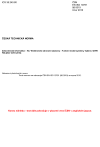ČSN EN ISO 10781 (980019) Aktuální vydání
Zdravotnická informatika - HL7 Elektronické zdravotní záznamy - Funkční model systémy, Vydání 2 (EHR FM) (ISO 10781:2015)
Anotace obsahu normy
The HL7 EHR System Functional Model provides a reference list of functions that may be present in an Electronic Health Record System (EHR-S). The function list is described from a user perspective with the intent to enable consistent expression of system functionality. This EHR-S Functional Model, through the creation of Functional Profiles for care settings and realms, enables a standardized description and common understanding of functions sought or available in a given setting (e.g. intensive care, cardiology, office practice in one country or primary care in another country).
The HL7 EHR-S Functional Model defines a standardized model of the functions that may be present in EHR Systems. From the outset, a clear distinction between the EHR as a singular en-tity and systems that operate on the EHR, i.e. EHR Systems, is critical. Section 1.1.3 describes the basis and foundation for the HL7 definition of an EHR System. Notably, the EHR-S Functional Model does not address whether the EHR-S is a system-of-systems or a single system providing the functions required by the users. This International Standard makes no distinction regarding implementation; the EHR-S described in a Functional Profile may be a single system or a system of systems. Within the normative sections of the Functional Model, the term "system" is used generically to cover the continuum of implementation options. This includes "core" healthcare functionality, typically provided by healthcare-specific applications that manage electronic healthcare information. It also includes associated generic application-level capabilities that are typically provided by middleware or other infrastructure components. The latter includes intero-perability and integration capabilities such as location discovery and such areas as cross appli-cation workflow. Interoperability is considered both from semantic (clear, consistent and persistent communication of meaning) and technical (format, syntax and physical connectivity) viewpoints. Further, the functions make no statement about which technology is used, or about the content of the electronic health record. The specifics of 'how' EHR systems are developed or implemented is not considered to be within the scope of this model now or in the future. This EHR-S Functional Model does not address or endorse implementations or technology, nor does it include the data content of the electronic health record.
Finally, the EHR-S Functional Model supports research needs by ensuring that the data available to researchers follow the required protocols for privacy, confidentiality, and security. The diversity of research needs precludes the specific listing of functions that are potentially useful for research.
This Functional Model is not:
- a messaging specification;
- an implementation specification;
- a conformance specification;
- an EHR specification;
- a conformance or conformance testing metric;
- an exercise in creating a definition for an EHR or EHR-S.
The EHR-S Functional Model is not sufficient to provide a longitudinal health record; however, it will contribute to its development. The information exchange enabled by the EHR-S supports the population of clinical documents, event summaries, minimum data sets, claims attachments, and in the future will enable a longitudinal health record.
Additionally, it is important to note that the EHR-S Function Model does not include a discussion of clinical processes or the interaction of the healthcare actors. However, ISO 13940 is an inter-national standard that does outline key principles and processes in the provision of healthcare. Users of the EHR-S FM can refer to ISO 13940 for clinical processes that EHR systems support.
| Označení | ČSN EN ISO 10781 (980019) |
|---|---|
| Katalogové číslo | 98828 |
| Cena | 590 Kč590 |
| Datum schválení | 1. 2. 2016 |
| Datum účinnosti | 1. 3. 2016 |
| Jazyk | angličtina (obsahuje pouze anglický originál) |
| Počet stran | 84 stran formátu A4 |
| EAN kód | 8590963988283 |
| Tato norma nahradila | ČSN EN ISO 10781 (980019) z srpna 2010 |
| Dostupnost | skladem (tisk na počkání) |


